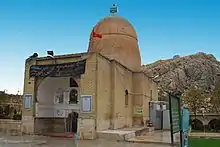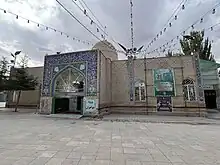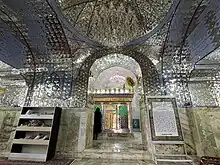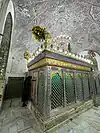| Mausoleum of Prophet Qeydar | |
|---|---|
آرامگاه قیدار نبی | |
 | |
| Religion | |
| Affiliation | Shi'a |
| Province | Zanjan Province |
| Status | Active |
| Location | |
| Location | Qeydar, Khodabandeh County, Iran |
| Geographic coordinates | 36°06′59″N 48°35′08″E / 36.11629°N 48.58542°E |
| Architecture | |
| Founder | Bulughan Khatun (wife of Ghazan) |
| Date established | 1316 |
| Specifications | |
| Dome(s) | 1 |
| Site area | 120.35 square metres (approximately) |
| Shrine(s) | 1 |
| Materials | bricks and stone |
The Mausoleum of Prophet Qeydar (Farsi: آرامگاه قیدار نبی) is a historic mausoleum located in the city of Qeydar in Khodabandeh County, Iran.[1][2][3] The mausoleum is believed to entomb the remains of Qedar, one of the sons of Ishmael and hence a grandson of the biblical Abraham. This mausoleum is the 321st national monument of Iran.[2][1]
History
The present mausoleum was built in 1316 by the wife of Mahmud Ghazan, Bulughan Khatun.[1][2] A further restoration was funded by a Sufi leader, Timur Khan Soltaniyeh, in 1351.[1][2] However, an earlier structure existed before the 14th century.[1][2]

Architecture
The mausoleum of Prophet Qeydar has an area of approximately 120.40 square metres, in a rectangular shape.[2][1] A simple brick dome tops the mausoleum. On the southern side of the shabestan is an early Nastaliq inscription dating back to 1316, which details the first construction by Bulughan Khatun.[2][1]

The building is entered from the southern side.[2][1] On the western side of the building, there is a basement, which was intended as a farm for cattle. There are also rooms and hostels that were constructed for visitors and pilgrims.[1][2]

Inside the mausoleum, the alleged grave of the Prophet is located underneath the dome.[2][1] It is covered by a zarih, and made of walnut wood.[2][1] Islamic calligraphy is engraved onto the zarih, and gold is embedded in it as well.[2][1]
Artifacts
The mausoleum houses an ancient copy of the Holy Qur'an. It is written on papyrus, with a cover made of leather.[2][1]
Gallery
 A gateway to the mausoleum, viewed from the inside
A gateway to the mausoleum, viewed from the inside A view of the exterior of the mausoleum, with a swimming pool in the foreground.
A view of the exterior of the mausoleum, with a swimming pool in the foreground. Nastaliq inscription in the mausoleum
Nastaliq inscription in the mausoleum The purported tomb of Qedar
The purported tomb of Qedar Some detailing underneath the dome
Some detailing underneath the dome
See also
References
- 1 2 3 4 5 6 7 8 9 10 11 12 13 https://zanjan.mcth.ir/en/Database/agentType/View/PropertyID/3118
- 1 2 3 4 5 6 7 8 9 10 11 12 13 "آرامگاه قیدار نبىّ ع ـ خدابنده :: مزارات ایران و جهان اسلام". shrines.ir. Retrieved 2023-11-28.
- ↑ "آرامگاه پیامبری در زنجان که جانشین حضرت اسماعیل (ع) بود + تصاویر - تسنیم". خبرگزاری تسنیم | Tasnim (in Persian). Retrieved 2023-11-28.